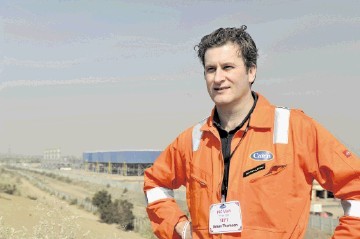
A year into the top role at Cairn Energy, Simon Thomson is running a different company to the one he took over in July 2011.
Cairn has sold out of its core Indian operations – responsible for about 30% of India’s oil output – shrunk from a £10billion business to a £1.8billion market cap and launched itself into the North Sea through buying Stavanger-based Agora Oil & Gas in April and now a £414million bid for Nautical Petroleum.
The two firms would give it North Sea reserves totalling 192million barrels oil equivalent – not including the recent Skarfjell discovery in Agora’s portfolio and the successful Carnaby well, which sits in the Greater Catcher Area, 15% part-owned each by Agora and Nautical (potentially giving Cairn 30%) – and production from 2015.
For Cairn, Catcher is core. Currently subject of a development concept selection process, with operator Premier Oil putting CAPEX in the range $1.6-2.8billion, and new 3D survey work, Cairn thinks this area has potential beyond the three known discoveries in the block – Catcher, Varadero and Burgman.
Cairn’s 2C resource estimate is 130million barrels – compared with Premier’s 80million estimate.
Cairn also sees upside in Kraken, in which it would pick up a 25% carried stake through buying Nautical, with 50% in the nearby Ketos prospect, 6% in Mariner, plus assets in southern England, Irish Sea and France.
Despite this huge and rapid shift of emphasis into the North Sea, weighted on Norway through Agora, Cairn says its own operational efforts will be elsewhere – frontier “transformational” areas where it believes it has an edge.
It has applied for a joint licence off Cyprus, has reiterated its continued belief in Greenland, where Statoil has joined it as a partner in the Pitu block, has plans to apply for blocks off Lebanon later this year and is assessing acreage off Spain, for good measure.
There is also a wild card – “one other area”, Thomson says, not being drawn.
“We see a lot of opportunities in the greater Med region. That is why it is a fascinating region, all with different returns and balances of risk and reward.
While it is waiting to apply in Lebanon and for news on its Cyprus applications, Thomson said the firm is looking to shoot 3D seismic by the end of the year off Spain and wants more acreage in the market ready space – 98% of Spain’s energy is imported, he says.
Despite having not yet been successful off Greenland, Thomson says its work there to date gives it an edge, both in terms of the data it now holds on the area but also showing how it has operated.
“The fact is, for a relatively small company, we have carried out – incredibly safely and efficiently – a major drilling campaign over a two-year period and that stands us up very good in places like Cyprus.
“We want to be somewhere we can establish an edge. In the North Sea you can do that and we believe we can do that in the Mediterranean as well.”
The focus on Greenland continues too. Cairn is in a consortium including Shell, which is collecting core samples from offshore Greenland, indicating others’ interest in the basin.
Two seismic programmes shot last year are being interpreted this year in connection with the well data it has gathered.
“As a board we decided to spend £1billion to explore for two years and drill as much as we could and recognise it was high risk,” he said. “Even if we didn’t make a discovery, we recognised what the data gave us.”
There could be more drilling in the Pitu basin, which Statoil farmed into, next year, he says, but more likely 2014. Anywhere else would be in partnership, such as southern Greenland, which offered “encouraging 3D seismic”, he said.
The “transformational” focus outside of the North Sea, does not, however, detract Cairn from the opportunities in this mature basin.
“As people focus on different play types, there is a whole lot more to come in the North Sea,” said Thomson.
“The Norwegian sector is relatively unexplored in comparative terms. We think we are accessing at a time not when things are tired but an exciting time with new plays opening up. With the right skills we can build a significant base.
“Within a few years this can provide enough cash flow to sustain exploration on the riskier side of the scale.”
With that risk and pending licence applications, there could still be a lot of change at Cairn. “We’re still in transition,” said deputy chief executive Mike Watts in a recent analyst call. “By the end of this year we’ll be a different company, and by the end of next year we’ll be a different company still.”